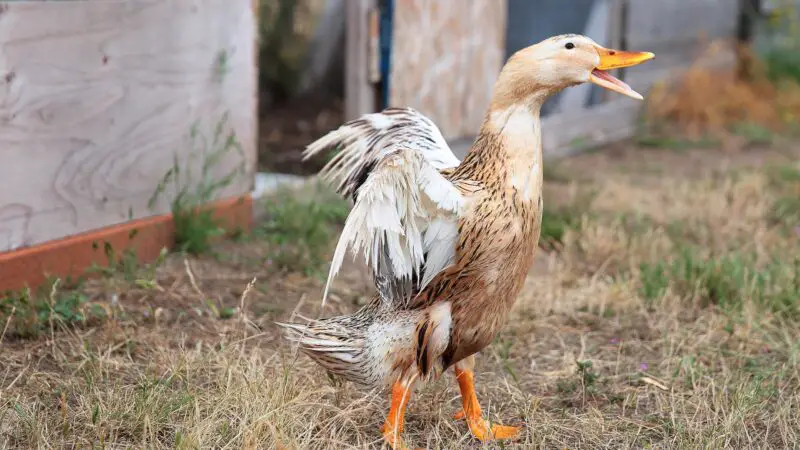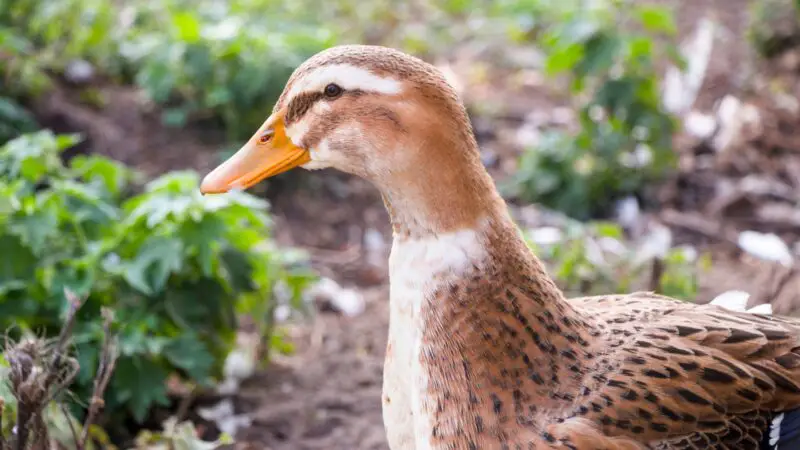Ducks can be raised under a wide range of conditions, from backyard coops to modern housings to commercial duck farms, depending on their population. An important aspect of raising ducks is choosing the breed. If you want a multipurpose breed, the Silver Appleyard duck is the most ideal choice for you!
Silver Appleyard duck is a large-sized, sturdily-built duck with white or chestnut plumage, depending on the sex. It can be raised for its lean meat quality, prolific egg-laying capabilities, calm and docile temperament, or beauty.
If you want to know more about Silver Appleyard ducks, their origin, appearance, distinctive characteristics, and other interesting information, read further this article!
Silver Appleyard Duck History
This breed was created in the 1930s by expert poultry breeder Reginald Appleyard, who also developed the Ixworth Chicken at his famous farm, the Priory Waterfowl Farm located near Bury St. Edmunds, England. According to the farm’s brochure, he wanted to create a beautiful, white-skinned, and deep-breasted breed that can lay abundant eggs.
By the 1940s, his birds won prizes at the Bethnal Green and Dairy Show. He then created a bantam variety by cross-breeding Call and Khaki Campbell ducks, but they did not have the same genetic makeup as the original bird. Appleyard continued working and stabilizing the breed until he died in 1964, but he was not able to establish a working standard.
Silver Appleyard ducks were introduced in the United States in the 1960s, but they were not available publicly until 1984. In 2000, the American Poultry Association officially included the breed in their Standard of Perfection. Today, they are considered relatively rare and are even considered by the Livestock Conservancy.
Silver Appleyard Duck Identification

What Do Silver Appleyard Ducks Look Like?
The Silver Appleyard duck is a large-sized duck with a sturdy build and blocky physique. Drakes have a chestnut flank, breast, sides, and shoulders with lacing and frosting, as well as a silvery white or creamy underside.
They also have a greenish or yellowish bill, dark bronze tail feathers, orange legs and feet, and gray and white wings with a bright blue cross-stripe.
Hens have a whitish plumage with markings in varying shades of gray and brown. Their bills are orange or yellow with a black bean. They also have orange or yellow legs, dark toenails, and the same marked wing pattern as drakes.
According to the standards of the British Waterfowl Standards, both sexes are ideal in appearance if they have a well-rounded head that has iridescent green feathering, a brown-black rump with white lacing and a slight iridescence, legs that are set well apart and slightly back, medium-length beak, and dark brown eyes.
How Long Does a Silver Appleyard Duck Live?
It has a life expectancy of 4 to 8 years, but it can live as long as 12 years or more when given the proper amount of care and maintenance.
What Do Silver Appleyard Ducks Eat?
Since they are domestic ducks, they are fed with commercial, nutritionally-balanced duck feeds that are either in pellet or crumble form. If they are not readily available, owners will feed them with chicken feed instead.
How Big Do Silver Appleyard Ducks Grow?
There is no information about the size of Silver Appleyard ducks, but since they are large-sized birds, they may be around 25 to 34 inches.
Are Silver Appleyard Ducks a Heavy Breed?
Silver Appleyard ducks are a heavy breed, with females weighing 3.2 to 3.6 kilograms while males weighing around 3.6 to 4.1 kilograms.
Silver Appleyard Duck Wingspan
There is currently no information regarding this either but their wingspan maybe around 32 to 39 inches long.
What Is Silver Appleyard Duck Known For?
Silver Appleyard ducks are a multipurpose breed. They are grown for their lean meat (as gourmet roasting ducks), eggs, and for exhibition. They can also be kept as pets.
Where Do Silver Appleyard Ducks Originate?
They originate from England, specifically from Reginald Appleyard’s farm, the Priory Waterfowl Farm, located near Bury St. Edmund.
What Are the Distinct Characteristics of a Silver Appleyard Duck?
Silver Appleyard ducks are revered for their lean, flavorful meat, prolific egg-laying abilities, and beauty.
Silver Appleyard Ducks Temperament
They have calm, docile, and friendly temperaments and are not known for being flighty as long as they are well-fed. Silver Appleyards are active foragers and are quite interactive with humans and other animals.
When Do Silver Appleyard Ducks Lay Eggs?

Silver Appleyard ducks start producing eggs at 6 months of age. Depending on when they mature, they begin laying eggs during the spring season.
How Often Do Silver Appleyard Ducks Lay Eggs?
They can lay eggs nearly every day, usually starting during the spring season.
What Color Are Silver Appleyard Duck Eggs?
They produce large or extra-large white eggs.
How Many Eggs Do Silver Appleyard Ducks Lay?
They can produce 220 to 265 eggs, making them one of the most prolific layers among the heavyweight breeds of ducks.
At What Age Do Khaki Silver Appleyard Ducks Start Laying Eggs?
As early as 6 months of age.
Silver Appleyard Ducks Care Tips

Housing
Silver Appleyards should be provided with a clean, dry, and sheltered but partially enclosed area to protect them against extreme weather conditions as well as predators. It should be placed in a high, well-draining area. Sandy soil is preferable since it drains fairly quickly after rains.
The floor of the housing should be bedded with shavings, straw, or other similar, absorbent material. Fencing should be constructed to keep them from escaping the area. Inexpensive wire mesh or other netting should also be put around the open areas of the shed to ward against predators.
Moreover, although ducks do not require water for swimming to be able to develop and reproduce properly, providing an area for them to swim or wade is still beneficial, especially when you live in a hot region.
Nutrition
Ducklings should be provided with 23% protein commercial starter crumble or chick starters if the former is not available. They will consume about half a pound of feed in their first week.
When they reach 2 weeks of age, switch to a 20% protein grower pellet. Once they exceed 8 weeks of age, provide an 18% protein broiler finisher ratio.
Additionally, clean drinking water should be readily available and accessible to your ducks for at least 8 to 12 hours daily.
Feeder and Waterer
Start with small feeders for ducklings, then gradually increase their size as the ducks mature. As a rule of thumb, the height of the feeder pan should be level with the back of the duck. On the other hand, the waterer pan height should be level at the neck area while the nipples should be placed at a slightly higher level.
Feeders and waterers should be regularly cleaned as well as protected from sun, wind, and precipitation to reduce wastage. Use a commercial non-toxic disinfectant for sanitizing at least 3 times weekly.
Healthcare
Bring your ducks annually to your local veterinarian for routine health examinations. They should be immunized against infectious diseases by proper administration of bacterins and vaccines. To minimize and ultimately prevent your ducks from contracting illnesses, make sure their housing area is regularly clean and sanitized.
Breeding Silver Appleyard Ducks
- Since Silver Appleyards can go broody, their ducklings can directly be brooded by them. However, if the ducklings aren’t hatched by the hens, they can be placed under them in a confined area during nighttime so that they will accept the ducklings.
- For the ducks’ brooder house, a barn corner, garage, and other appropriately renovated buildings can work for a small number of birds. This house should be dry, draft-free, well-lighted, and well-ventilated.
- Use 2 125-watt infrared heat lights to use a heat source when brooding. It should be suspended 18 inches from the floor. The temperature should be at 85°F to 90°F when the ducklings arrive. Reduce 5 to 10 degrees weekly as they grow.
Related Questions
Is Silver Appleyard Duck Good to Eat?
Silver Appleyard ducks are good to eat, they are known for having lean, flavorful meat as well as good-quality eggs.
Do Silver Appleyard Ducks Go Broody?
Silver Appleyard hens have great mothering instincts.
Are Silver Appleyard Ducks Loud?
Silver Appleyard ducks are not loud, they are relatively quiet compared to other breeds, making them great backyard ducks as they are not a nuisance to neighbors.
Are Silver Appleyard Ducks Good Pets?
Silver Appleyard ducks are good pets, due to their calm, friendly, and docile temperaments.
How Much Is a Silver Appleyard Duck Worth?
They cost around $6.18 to $17.94, depending on age, quality, and sex. Usually, females and unsexed ducklings are more costly than males, costing up to 3 times as much as the latter.
Are Appleyard Ducks Friendly?
Silver Appleyard are friendly, they are, especially when they are hand-raised from when they were hatchlings or at a young age.
